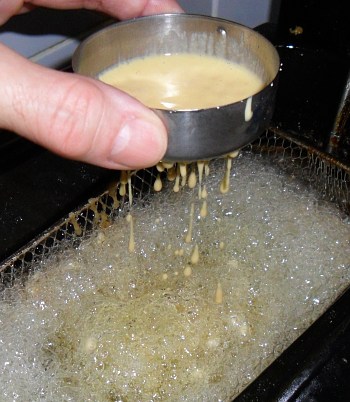 |
Ideally, you want a concave surface with
equally sized holes around 4mm in diameter. |
In a bowl, mix the besan, white flour, rice flour and baking powder.
Gradually add sufficient water to make a batter of the consistency that you can see in the picture on the right.
Do this gradually, mixing all of the time with a spoon so that any balls of besan that are formed, can be squashed out and mixed in.
Leave the batter for five minutes to let any dry besan balls of air float to the surface so that you can mix them in.
If you seem to have too many of them or they are proving too difficult to remove, you can put the mixture through a sieve.
Put a piece of kitchen foil in the bottom of the fryer's basket so that batter will not fall through it or stick to it during cooking.
Heat the oil in the deep oil fryer to 180 Celsius.
Push the foil back in place - it gets caught up in the convection currents as the oil heats.
 |
First, the batter balls sink and then
they rise up and fry on the surface. |
Using your chosen 'holey implement', pick up around 50mls of batter in a ladle and, holding the implement around 4" above the surface of the oil, pour the batter into the oil, moving the implement along the length of the fryer so that they do not all fall in the same place.
The boondi will sink to the bottom of the pan - hence the kitchen foil - and then rise to the surface again, as little golden batter balls.
 |
Drain them on some kitchen towel
before you use them - still hot. |
Allow the boondi to fry until golden.
Spoon them out (draining them into the fryer) into a bowl lined with paper kitchen towel.
They can carry a lot of oil so make sure that during this process, they don't carry too much out of the deep oil fryer.
Also, make sure that the bowl you put them in has enough thickness of paper towel.
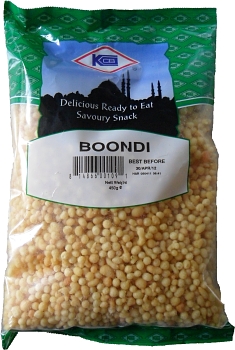 |
If you can't be bothered, or haven't got time to make
your own boondi, you can get the plain boondi as a snack |
If you have tried the process above and decided that you can't be bothered with it - if you haven't tried it, I recommend that you do because it is quite fun to do - then you can bypass the above steps in the boondi manufacturing process by buying ready-made boondi.
This is sold as a savoury snack but it hasn't got anything in it that the recipe above has - no flavourings added - so you can substitute it directly if you want.
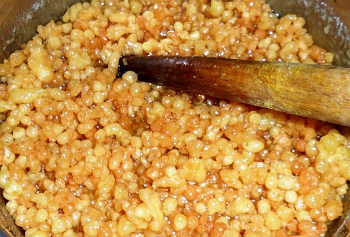 |
Mixed in with the syrup. Finally, use a spoon to lift
the syrup off the bottom of the pan and mix it in. |
When each batch as drained on the kitchen towel, add it to the syrup.
Make sure that all of the balls are immersed in the syrup or as you got closer to the end, that they all come into contact with it all over.
When you finally complete the boondi manufacturing process and have added it to the syrup, spoon the syrup up from the bottom of the saucepan and pour it over the rest of the boondi, making sure that the mixture is evenly distributed.
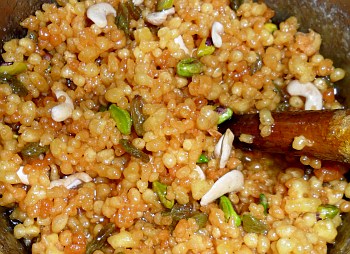 |
This is with green sultanas,
pistachios and cashews added. |
You can add anything you like to this mixture or just leave it plain.
This is cashews, pistachios and green sultanas.
Note that there are not that many bits that have been added. This is because that if you add too much, the mixture will tend to fall apart when you are trying to perform the next bit.
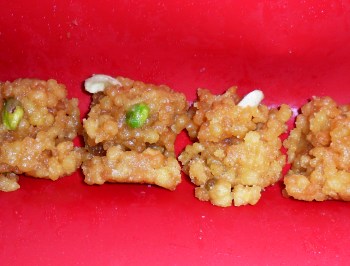 |
One alternative to putting them on a flat surface is to
roll them in a silicone sheet, analogously to making sushi. |
Finally, you need to make separate sweets from this mixture.
You can either make neat spheres, around 3cm in diameter, just like the ones that you see in the Indian sweet shops, or you can opt for a shape that doesn't require asbestos hands.
In each case, take a quantity that would give you a sphere of around 3cm in diameter if rolled into a sphere and:
- Roll it into a sphere, placing each one on a piece of non-stick baking/greeseproof sheet - this takes time, practice, the mixture being the correct temperature and patience (and heat-proof hands).
- Make little piles of the mixture and try to make them as compact as you can.
- Use a silicone rubber mat to form a 'furrow' about 3cm across and then put enough mixture for six or so in there, compacting the mixture and making spaces between them.
- You could also use any type of mould such as silicone cake moulds and so on.
Whilst you can see that this is a little like those puffed rice/toffee squares that your mother made for you as a child, the sugar in boondi ladoo is just sucrose - there is no glucose in there.
As a result, casting it into a block and then cutting that up into squares has a very low success rate because the squares tend to fall apart.
One thing that you can do with any left over bits is use them as a topping for custard, ice cream and so on. They only have a mild flavour and will not eliminate the vanilla in custard and so are ideal for that.
The reality of it is that you are not making these for sale in a shop or for a wedding. You are making them so that you can have them with your meal at work so it doesn't really matter what they look like as long as you have the right amount and they don't fall apart in transport or during consumption.
So, finally, we have bite-sized pieces of boondi ladoo that are very filling and having plenty of sugar and an unknown (but hopefully minimal) quantity of oil in them. They will provide you with warmth and energy in the middle of your shift.
 |
Finished Boondhi Ladoo. Balls? You can make spheres if you want
but this is the practical option. A mixture of flat surface and rolled. |